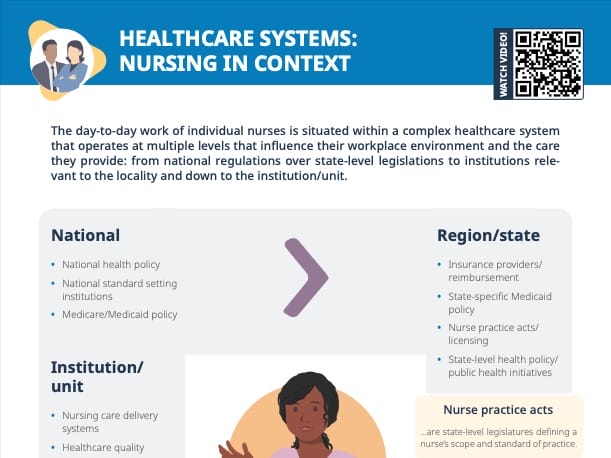What are care delivery models?
Care delivery models are the operational mechanisms by which care is provided to patients and families. They define foundational strategies that dictate how healthcare services, particularly nursing care, are organized and delivered, and are supposed to optimize resources while improving patient outcomes.
Each model assigns specific responsibilities and roles to healthcare professionals based on a system that can range from focusing on individual patient-nurse relationships, through to team-based or even unit-based approaches. The choice of a care delivery model can depend on various factors, including the setting of care, patient needs, staff availability, and organizational goals.
Model #1: Total patient care
What does total patient care mean?
In total patient care, the RN assumes responsibility for a group of patients for the duration of a shift and provides all care to this group of patients.
Advantages of total patient care
Total patient care provides continuity for the shift and ensures clear responsibilities. For nurses, it is generally a satisfying system of providing care.
Disadvantages of total patient care
Total patient care can be very expensive while not utilizing RN’s time wisely. Especially with staffing shortages, following this model may not be possible.
Model #2: Primary nursing
What is primary nursing?
In primary nursing, RNs assume 24/7 accountability for their primary patients, establish a plan of care, and coordinate that care plan even in their absence.
Pros of primary nursing
Next to ensuring excellent holistic care for patients, primary nursing as a care model also leads to high job satisfaction of nurses.
Cons of primary nursing
Primary nursing is difficult to implement in today’s flexible scheduling, and requires a high RN mix. Additionally, some staff do not want to accept the accountability and responsibility that comes with the primary nursing care delivery model.
Model #3: Functional nursing
What is functional nursing?
In functional nursing, staff members are assigned to a specific task (or group of tasks) for patients. Examples include being the designated “medication nurse,” “IV nurse,” “vital signs person” for the shift. The RN assumes overall direction of care.
What are the benefits of functional nursing?
This care delivery model incorporates the use of LPNs and UAPs. It maximizes the use of their skills and can be a cost-effective way of providing care.
What is a disadvantage of functional nursing?
On the downside, functional nursing can lead to fragmentation and gaps in patient care – splitting up the care of one patient into these different types of tasks works against holistic patient care, which can lead to loss of focus on the bigger picture and the patient as a whole.
Model #4: Team nursing/modular nursing
What is team nursing?
In team or modular nursing, the RN team leader coordinates care for a group of patients working with other team members, utilizing their skills.
What is an advantage of team nursing?
An advantage of team nursing is that it is very satisfying for staff and patients, and can be quite cost-effective.
Disadvantages of team/modular nursing
On the other hand, team nursing requires high-level leadership skills from the RN to function well. It is also harder to do with high patient acuity and inconsistent team members.
Team nursing vs primary nursing
The main difference between the team nursing model and primary nursing is that in team nursing, a group collaboratively cares for a patient group while being supervised by a team leader, whereas in primary nursing, one nurse oversees all aspects of care for a single patient.
Model #5: Case management
What is case management?
In the case management model of care delivery, an RN case manager supervises the use of resources across the continuum and lays focus on individual patients.
Advantages of case management as a nursing care delivery model
Case management is very cost-effective and satisfying especially for patients who are high-risk or problem-prone.
Disadvantages of case management as a nursing care delivery model
Case management is not a true inpatient delivery system but rather the management of patient care.
